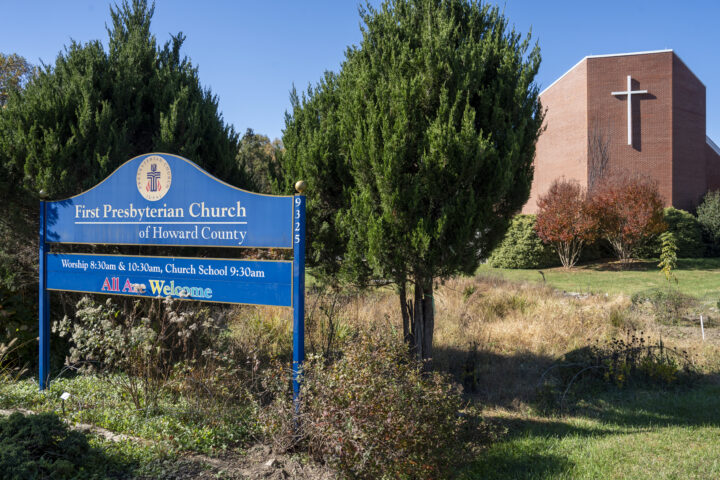7/15/2025
Fire damages sanctuary and fellowship hall of First Presbyterian Church of Howard County

Columbia, MD – A lightning-caused gas line fire ignited at First Presbyterian Church of Howard County (Maryland) in the early evening hours of July 1, 2025, triggering damage to the church’s fellowship hall, sanctuary, and the structural beams that support the sanctuary floor.
The church is out of the building for worship for the next six to 12 months while restoration work is underway, church officials said. The congregation is part of the Presbytery of Baltimore, and is located about 20 miles south of the city. Average worship attendance is about 175, according to the most recent statistical report.
Interim pastor the Rev. Ken Page was at the church preparing for a 7 p.m. meeting when one of the meeting participants ran into the office around 6:50 pm saying she smelled gas. Page made his way to the nearest exit while the church’s Director of Christian Education, Virginia Callegary, went downstairs to investigate.
Callegary came outside and told the others she smelled smoke and saw water in the fellowship hall. A call to the fire department quickly brought fire crews, 10 trucks in total, to contain the blaze.
“The fire marshal suspects a lightning strike traveled through a lighting rod or up from the ground and into our gas line,” Page said. “The gas ignited and found a way out, blowing a hole in the pipe that runs in the ceiling of our fellowship hall, directly under the sanctuary stage.”
Thunderstorms had passed through the area on a hot and humid afternoon, but the fire wasn’t discovered until a few hours later.
“We never heard a local lightning clap,” said Page, who had been at the building during the storm. “Like when you see and hear the lightning at the same time and it makes you jump out of your skin.”
No one is sure how long the gas fire burned. A torch of flame burned the insulation around the pipe and set off one sprinkler, but due to the confined nature and no other burning materials, the primary fire alarm didn’t go off until after fire crews had arrived. The force of the flame from the burst pipe was intense enough that it melted part of the structural beams supporting the sanctuary’s four-inch-thick concrete floor. The concrete floor became so hot that it ignited portions of the sanctuary stage, resulting in the smoke that triggered the alarm.
“Once the gas was turned off and things cooled down the fire dissipated quickly,” said Page. “Crews used some water to cool off the beams downstairs [in the fellowship hall] then used chainsaws and other tools to remove the portions of the smoldering stage. It was so hot and humid, they had to swap out crews after two hours.”
In the wake of the fire, cleanup crews continue their smoke mitigation and renovation efforts. A faint “campfire” smell remained in the sanctuary a week after the fire and specialists in church fire restoration have been contracted to clean pews, bibles, hymnals and instruments. The only instrument lost, said Page, is likely the fellowship hall piano.
“It could have been much worse,” he said. “We were fortunate the fire was contained to a small area, and it was stopped before it ignited a larger fire in the sanctuary. The fire crew did incredible and careful work.”
With the church’s sanctuary unusable for the foreseeable future, four local PC(USA) congregations stepped in to offer their support ranging from combining services to arranging for First to use their sanctuaries for worship before or after their own services.
The congregation decided to join the worship service at Christ Memorial Presbyterian Church the Sunday after the fire. The session knew there was a long road ahead for the church’s restoration and said, “at least for this first week, let’s just let them minister to us.”
A long-term plan for worship location hasn’t yet been determined. First’s original sanctuary, now used as a chapel, is a likely option, though a determination of occupancy from the fire marshal will determine these next steps.
“This church has very talented lay leaders,” said Page of the groups coordinating these efforts, including cleanup and restoration. “We have an insurance guy who’s dealing with that, and we have the Building and Grounds committee that’s dealing with that kind of stuff. And I’m staying informed, but I’m focused on doing pastor stuff.”
The church has also been contacted by Presbyterian Disaster Assistance, Board of Pensions, and the Presbyterian Foundation to see what assistance they can provide. Page said he and the congregation are appreciative of the concern they’ve received while they consider how to proceed.
“The best estimate is that it will be six months to a year before we worship in the sanctuary,” he said. “A lot of that depends on what needs to be done to repair or replace the structural beam under the sanctuary.”
He said people are experiencing “some anxiety, some tears. A lot of ‘we’re so glad nobody was hurt, and they were so glad it wasn’t worse,’ and some definite pulling together. So a broad range of stuff, like you’d expect. Nothing that I think, oh, that’s a bit beyond the circumstances. It’s significant, but no, it’s not catastrophic.”
Even though the congregation may be displaced from the church’s sanctuary, Page said the congregation has a good understanding about the theology of worship spaces that will help them weather the next several months.
“No matter how connected we get to [the sanctuary]. It’s not the place, it’s just a room,” he said. “It’s not the only place you meet God. We use the word sanctuary, but we don’t actually believe there’s anything holy about the room.”
